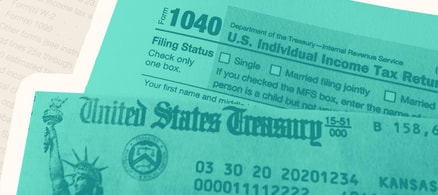What is the Saver’s Credit?
The Saver’s Credit — also known as the Retirement Savings Contributions Credit — is a tax credit that can be claimed by eligible taxpayers who contributed to a retirement account during the tax year.
Eligible retirement accounts include a traditional or Roth IRA, 401(k), 403(b), 457(b), or SIMPLE plan. The maximum amount of the credit is $1,000 for individuals ($2,000 for a married couple filing jointly).
If this is the first you’re hearing about the Saver’s Credit, well, that’s common. The latest data found that just 6.1% of taxpayers claimed the Saver’s Credit in 2019.
Meet Your Retirement Goals Effortlessly
The road to retirement may seem long, but with WiserAdvisor, you can find a trusted partner to guide you every step of the way
WiserAdvisor matches you with vetted financial advisors that offer personalized advice to help you to make the right choices, invest wisely, and secure the retirement you've always dreamed of. Start planning early, and get your retirement mapped out today.
Get StartedWho can claim the Saver’s Credit?
To be eligible for the Saver’s Credit, you must meet these requirements:
- Age 18 or older,
- Not claimed as a dependent on someone else’s return, and
- Not a full-time student
Next, you must have contributed to a retirement plan, which can be a 401(k) or other employer-sponsored plan, or a traditional or Roth IRA. In addition, your earnings must not top the specified income thresholds.
How do you qualify for the Saver’s Credit?
You can take the Saver’s Credit if your adjusted gross income is:
- Up to $68,000 for a married couple filing jointly in 2022; for 2023 it’s $73,000
- Up to $51,000 for a head of household filing in 2022; for 2023 it’s $54,750
- Up to $34,000 for all other taxpayers (including individuals) filing in 2022; for 2023 it’s $36,500
Not eligible? A financial adviser can help you find other ways to get more from your retirement savings.
Stop overpaying for home insurance
Home insurance is an essential expense – one that can often be pricey. You can lower your monthly recurring expenses by finding a more economical alternative for home insurance.
SmartFinancial can help you do just that. SmartFinancial’s online marketplace of vetted home insurance providers allows you to quickly shop around for rates from the country’s top insurance companies, and ensure you’re paying the lowest price possible for your home insurance.
Explore better ratesHow much is the Saver’s Credit worth?
The dollar value of the Saver’s Credit is calculated based on your adjusted gross income, your tax filing status and the amount you contribute to an eligible retirement account during a tax year.
You may be eligible to claim 50%, 20% or 10% of the first $2,000 you contributed if you’re an individual, or $4,000 if you’re a married couple filing jointly.
If you want to use the tax credit when you file your 2022 tax return, check the list below to see how much you can get:
Married filing jointly
For 2022, if you’re married filing jointly, you can take:
- 50% credit if your AGI is $41,000 or less
- 20% credit if your AGI is between $41,001 and $44,000
- 10% credit if your AGI is between $44,001 and $68,000
You get no credit if your adjusted gross income is over $68,000.
Head of household
For 2022, if you’re filing as a head of household, you can take:
- 50% credit if your AGI is $30,750 or less
- 20% credit if your AGI is between $30,001 and $33,000
- 10% credit if your AGI is between $33,001 and $51,000
You get no credit if your adjusted gross income is over $51,000.
All other taxpayers (including individuals)
For 2022, all other filers can take:
- 50% credit if your AGI is $20,500 or less
- 20% credit if your AGI is between $20,501 and $22,000
- 10% credit if your AGI is between $22,001 and $34,000
You get no credit if your adjusted gross income is over $34,000.
To see how much the Saver’s Credit is worth for all tax years 2019 to 2023, visit the IRS site.
Example of how the Saver’s Credit works
For example, let’s say you’re a married couple filing jointly, you earned $38,000 last year, and contributed $1,000 to an eligible account. The value of your credit would be 50% of your $1,000 in contributions — or $500.
If you put in $5,000, only the first $4,000 would count, and your credit would reach the cap of $2,000.
Keep in mind, a credit is way better than a tax deduction. A deduction just reduces the amount of your income that’s subject to taxes, but a credit actually cuts your tax bill dollar for dollar.
What retirement accounts are eligible for the Saver’s Credit?
The IRS gives you several tax-advantaged options for saving for retirement — and taking advantage of the Saver’s Credit.
In addition to a 401(k), you can contribute to a traditional or Roth IRA, a SIMPLE IRA, 403(b) plan (for certain employees of public schools and tax-exempt organizations) or through a Thrift Savings Plan, which is open to federal employees and members of the uniformed services.
The IRS also extends the Saver’s Credit to Americans with ABLE accounts, which are savings plans for people with disabilities.
Deadline to contribute for the Saver’s Credit
The cutoff for many tax breaks is the end of the calendar year. For example, any donations to charity that you write off on your 2022 return must have been made during 2022. Makes sense, right?
But you can make retirement contributions right up to the April 18, 2023, tax deadline that will count toward the Saver’s Credit for that tax year.
To claim the saver’s credit, you must complete IRS Form 8880 and include it with your tax return. You’ll need two key pieces of information to fill out Form 8880: the adjusted gross income you calculated on your income tax return, and documents that show your retirement contributions for the year.
Does the thought of yet another tax form make your head spin? Don't worry, claiming the Saver’s Credit is a snap whether you file yourself with the help of good tax software or if you hire a tax professional.
More: File your taxes online with TaxSlayer
Sponsored
Follow These Steps if you Want to Retire Early
Secure your financial future with a tailored plan to maximize investments, navigate taxes, and retire comfortably.
Zoe Financial is an online platform that can match you with a network of vetted fiduciary advisors who are evaluated based on their credentials, education, experience, and pricing. The best part? - there is no fee to find an advisor.







